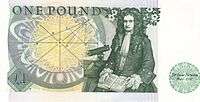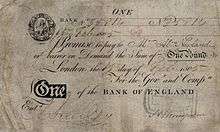Bank of England £1 note
| (United Kingdom) | |
|---|---|
| Value | £1 |
| Width | 135 mm |
| Height | 67 mm |
| Paper type | Cotton |
| Years of printing | 1797–1984 |
| Obverse | |
 | |
| Design | Queen Elizabeth II |
| Design date | 9 February 1978 |
| Reverse | |
 | |
| Design | Isaac Newton |
| Design date | 9 February 1978 |
The Bank of England £1 note was a banknote of the pound sterling. After the ten shilling note was withdrawn in 1970 it became the smallest denomination note issued by the Bank of England. The one pound note was issued by the Bank of England for the first time in 1797 and continued to be printed until 1984. The note was withdrawn in 1988 in favour of the one pound coin.
History

One pound notes were introduced by the Bank of England for the first time in 1797, following gold shortages caused by the French Revolutionary Wars. The earliest notes were handwritten, and were issued as needed to individuals. These notes were written on one side only and bore the name of the payee, the date, and the signature of the issuing cashier. Between 1797 and 1821 the lack of bullion meant that banks would not exchange banknotes for gold, but after the end of the Napoleonic Wars the shortage was alleviated such that notes could be exchanged for an equivalent amount of gold when presented at the bank. One pound notes ceased to be issued in 1821 and were replaced by gold sovereigns.[1]
During the First World War the British Government wanted to maintain its stocks of gold and so banks were ordered to again stop exchanging any and all denominations of banknotes for gold. Gold sovereigns were replaced by one pound notes issued by the Treasury. These notes were nicknamed "Bradburys" because of the prominent signature of Sir John Bradbury, Permanent Secretary to the Treasury displayed on the notes.[2] Britain returned to the gold standard in 1925, although the Bank of England was only obliged to exchange notes for gold in multiples of 400 troy ounces (12,000 g) (the typical size of a "Good Delivery bar") or more. The responsibility for the printing of one pound notes was transferred to the Bank of England in 1928, and the ability to redeem banknotes for gold ceased in 1931 when Britain stopped using the gold standard.[1]

The Bank of England's first post-World War I one pound notes were two-sided green notes which were printed – not handwritten. The name of the payee was replaced by the declaration "I promise to pay the bearer on demand the sum of one pound". This declaration remains on Bank of England banknotes to this day. This signature of the issuing cashier was replaced by the printed signature of the Chief Cashier of the Bank of England. In 1940, following the outbreak of the Second World War, one pound notes were issued in a new blue-orange colour scheme to deter counterfeiters, although the design remained the same. At the same time, metal thread running the paper was introduced as a security feature. After the war one pound notes were issued in their original green colour. The earliest post-World War II notes did not have the metallic thread security feature, but those issued from September 1948 onward did.[2]
A new design for one pound notes was introduced in 1960, with the old notes ceasing to be legal tender in 1962. These new series C notes were slightly narrower, and were the first one pound notes to feature a portrait of Queen Elizabeth II on the front. The reverse design incorporated the logo of the Bank of England. Series C notes were replaced by the series D notes from 1978 onward. These slightly smaller notes featured an entirely new design with Queen Elizabeth II on the front and the scientist Isaac Newton on the back. The note was redesigned slightly in 1981 to feature brighter background colours.[2] Following a consultation with retailers and other groups it was announced on 31 July 1981 that the one pound note would be replaced by a one pound coin. Part of the reason for this change was that notes, on average, lasted only nine months in general circulation, while coins could last forty years or more. The government also believed that the growing vending industry would benefit from the introduction of a one pound coin. The new cupro-nickel coin was introduced on 21 April 1983 and the one pound note ceased to be legal tender on 11 March 1988.[2][3]
Designs
| Note | First issued | Last issued | Ceased to be legal tender | Colour | Size | Design | Additional information |
|---|---|---|---|---|---|---|---|
| White | 2 March 1797 | 1821/1825–6 | Unknown | Monochrome (printed on one side only) | 200mm x 113mm (may vary) | ||
| Series A (1st issue) | 22 November 1928 | Unknown | 28 May 1962 | Green | 151mm x 85mm | ||
| Emergency wartime issue | 29 March 1940 | Unknown | 28 May 1962 | Pale blue and orange | 151mm x 85mm | Incorporated metal thread for the first time; same design as series A | |
| Series A (2nd issue) | 17 June 1948 | Unknown | 28 May 1962 | Green | 151mm x 85mm | Reissue of unthreaded pre-war notes | |
| Series A (3rd issue) | 13 September 1948 | Unknown | 28 May 1962 | Green | 151mm x 85mm | Metal thread introduced permanently | |
| Series C | 17 March 1960 | 1978 | 31 May 1979 | Green | 151mm x 72mm | Front: Queen Elizabeth II; Back: Bank of England logo | First £1 note to carry portrait of monarch |
| Series D | 9 February 1978 | 31 December 1984 | 11 March 1988 | Predominantly green | 135mm x 67mm | Front: Queen Elizabeth II; Back: Isaac Newton | Those issued from 20 March 1981 onward featured additional background colours. |
Information taken from Bank of England website.[1][2]
See also
References
- 1 2 3 "A brief history of banknotes". Bank of England. Retrieved 1 May 2016.
- 1 2 3 4 5 "Withdrawn banknotes reference guide" (PDF). Bank of England. Retrieved 1 May 2016.
- ↑ "One Pound Coin Designs and Specifications". Royal Mint. Retrieved 1 May 2016.